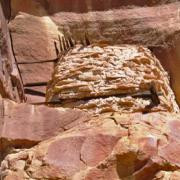Range Creek - Frequently Asked Questions
When is Range Creek Canyon open to visitors?
Access into Range Creek is via a steep, narrow, unimproved road that is not regularly maintained. This road is impassable during the winter months due to snow pack, rock/snow slides and debris. The date at which the road becomes passable varies year to year depending on weather conditions. We hope to open the canyon by May 15th, but, realistically, it can be as late as the end of June. The field station closes for the season on Nov. 30th.
What is the Range Creek Field Station?

The Range Creek Field Station was officially established on December 17, 2010 following a three-way land transfer between the State of Utah, Division of Wildlife Resources (DWR) and the State of Utah, School and Institutional Lands Administration (SITLA). Full management responsibilities for the property have been transferred to the Natural History Museum of Utah, the managing agency for the Range Creek Field Station.
How did the land transfer between DWR and the museum affect public access?
The Natural History Museum of Utah, the managing agency for the Range Creek Field Station, worked to ensure a seamless transition for hiking, camping, hunting and fishing enthusiasts. The policies and procedures established and described in the State of Utah Department of Wildlife Resources interim management plan remain in place in our Comprehensive Management Plan. The policies governing public access were not affected by the transfer.
Why do I need a permit to enter Range Creek?
Limiting the number of visitors lessens our impact on this wild and remote place and enhances the experience of our visitors. In 2005, a permitting system was established to grant public access to the property yet ensure that the number of visitors coming into the canyon could be monitored. Twenty-eight (28) visitors per day are allowed into the Canyon. There is a Seasonal Pass processing fee of $1.00 per visitor over the age of five.
Where are the archaeology sites?
Fremont archaeology is very subtle and difficult to distinguish. This is not Mesa Verde - there are no grand cliff houses to see. Instead visitors who keep a sharp eye may expect to see rock art and granaries perched high on the cliffs so be sure to bring along a pair of binoculars. To protect the resource there are no marked trails or signs guiding visitors to sites.
What else can I expect to see?
Range Creek is a wild and beautiful place where sandstone cliffs tower above the narrow canyon. Visitors may catch sight of any number of species that inhabit the canyon including: wild turkeys, foxes, raptors, bears, mountain lions, bobcats, moose, deer and elk. Two old buffalo even call Range Creek their home.
The animals of Range are completely wild and are usually long gone at the slightest hint of a human presence leaving only tracks and scat as evidence of their passing. However, along the creek thick vegetation and the sound of the stream may result in an unexpected encounter. If you should encounter a wild animal keep your distance. Never approach any wild animal and NEVER get between an animal and it's offspring.
Why is public access limited to foot and horse traffic?
The road through Range Creek is a narrow, unimproved two-track without turnouts or parking areas. Vehicular access is limited to administrative personnel and commercial tour groups to ensure safety and to protect the canyon's archaeological and natural resources. BLM land within the canyon is designated wilderness which prohibits mechanized travel.
Can I camp in Range Creek?
Camping is allowed at the primitive campground that has been established at the North Entrance Gate. Amenities are limited to pit toilets and two metal fire rings. Open fires are allowed only inside these rings. Visitors must bring their own drinking water. Please show respect for fellow campers by observing 10:00 pm - 6:00 am quiet hours and by keeping pets under control at all times. Camping is NOT allowed inside the gated area. Camping is not allowed on BLM wilderness lands adjacent to the field station.